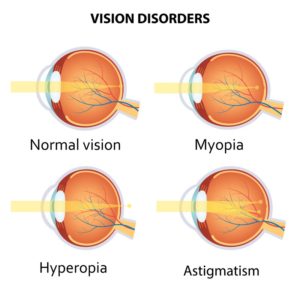Refractive Correction

What’s the Refractive Error?
Almost everyone has a refractive error. A refractive error occurs when light can not be sharply focused on the retina.
Common types of refractive errors are:
- Nearsightedness – also known as myopia
- Farsightedness – also known as hyperopia
- Astigmatism – a common secondary aberration in the focusing system of the eye
The number of people globally with significant refractive errors has been estimated at one to two billion. Rates vary between regions of the world with about 25% of Europeans and 80% of Asians affected.
Type of Refractive Correction
Correcting Refractive Errors
Glasses and contact lenses are often used to correct refractive errors, but glasses are expensive, can break and are often impractical to use in certain situations (e.g. sports). Contact lenses are also expensive, can cause corneal infections, can tear, fallout or get dirt underneath.
Laser vision correction, such as LASIK, can provide a long term alternative to contact lenses and glasses. LASIK works by changing the corneal surface. More specifically, it alters the curvature of the cornea to alter the refractive power of your eye – reducing or eliminating the need for glasses or contact lenses.
The Raindrop Near Vision Inlay also works by altering the corneal surface. A tiny clear inlay is inserted into the cornea producing a subtle change in the corneal surface. This is used to treat presbyopia – loss of near vision due to the natural aging process.
Older techniques such as radial keratotomy also “changed vision” by altering the curvature of the cornea. While LASIK has generally replaced RK, the basic ideas are the same; changing the corneal surface can result in improved vision without the need for glasses of contacts.

